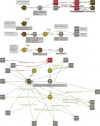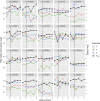Socially interactive industrial robots: a PAD model of flow for emotional co-regulation
- PMID: 39936108
- PMCID: PMC11811909
- DOI: 10.3389/frobt.2024.1418677
Socially interactive industrial robots: a PAD model of flow for emotional co-regulation
Abstract
This article presents the development of a socially interactive industrial robot. An Avatar is used to embody a cobot for collaborative industrial assembly tasks. The embodied covatar (cobot plus its avatar) is introduced to support Flow experiences through co-regulation, interactive emotion regulation guidance. A real-time continuous emotional modeling method and an aligned transparent behavioral model, BASSF (Boredom, Anxiety, Self-efficacy, Self-compassion, Flow) is developed. The BASSF model anticipates and co-regulates counterproductive emotional experiences of operators working under stress with cobots on tedious industrial tasks. The targeted Flow experience is represented in the three-dimensional Pleasure, Arousal, and Dominance (PAD) space. We present how, despite their noisy nature, PAD signals can be used to drive the BASSF model with its theory-based interventions. The empirical results and analysis provides empirical support for the theoretically defined model, and clearly points to the need for data pre-filtering and per-user calibration. The proposed post-processing method helps quantify the parameters needed to control the frequency of intervention of the agent; still leaving the experimenter with a run-time adjustable global control of its sensitivity. A controlled empirical study (Study 1, N = 20), tested the model's main theoretical assumptions about Flow, Dominance, Self-Efficacy, and boredom, to legitimate its implementation in this context. Participants worked on a task for an hour, assembling pieces in collaboration with the covatar. After the task, participants completed questionnaires on Flow, their affective experience, and Self-Efficacy, and they were interviewed to understand their emotions and regulation during the task. The results from Study 1 suggest that the Dominance dimension plays a vital role in task-related settings as it predicts the participants' Self-Efficacy and Flow. However, the relationship between Flow, pleasure, and arousal requires further investigation. Qualitative interview analysis revealed that participants regulated negative emotions, like boredom, also without support, but some strategies could negatively impact wellbeing and productivity, which aligns with theory. Additional results from a first evaluation of the overall system (Study 2, N = 12) align with these findings and provide support for the use of socially interactive industrial robots to support wellbeing, job satisfaction, and involvement, while reducing unproductive emotional experiences and their regulation.
Keywords: affect modeling; affective computing; arousal; emotion (Co-)Regulation; human-robot interaction; pleasure; social signals; socially interactive agents.
Copyright © 2025 Nunnari, Tsovaltzi , Lavit Nicora , Beyrodt , Prajod , Chehayeb , Brdar , Delle Fave , Negri , André, Gebhard and Malosio .
Conflict of interest statement
The authors declare that the research was conducted in the absence of any commercial or financial relationships that could be construed as a potential conflict of interest.
Figures








References
-
- Abuhamdeh S. (2021). “On the relationship between flow and enjoyment,” in Advances in flow research. Editors Peifer C., Engeser S. (Cham: Springer International Publishing; ), 155–169. 10.1007/978-3-030-53468-4_6 - DOI
-
- Alves da Silva C., Hilpert B., Bhuvaneshwara C., Gebhard P., Nunnari F., Tsovaltzi D. (2023). “Visual similarity for socially interactive agents that support self-awareness,” in Proceedings of the 23rd ACM international conference on intelligent virtual agents, 1–3.
-
- Arai T., Kato R., Fujita M. (2010). Assessment of operator stress induced by robot collaboration in assembly. CIRP Ann. 59, 5–8. 10.1016/j.cirp.2010.03.043 - DOI
-
- Aymerich-Franch L., Petit D., Ganesh G., Kheddar A. (2017). Object touch by a humanoid robot avatar induces haptic sensation in the real hand. J. Computer-Mediated Commun. 22, 215–230. Cited By 12. 10.1111/jcc4.12188 - DOI
LinkOut - more resources
Full Text Sources

